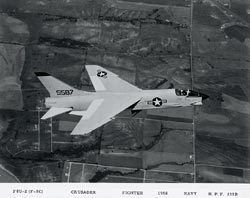|
 The development of the Pratt and Whitney J57P-16 engine, which delivered 13,000 pounds of static thrust at sea level and 17,500 pounds in afterburner, resulted in a request from the Navy for a further modification of the Crusader series. The fourth production F8U-1, BuNo 140477, was reworked as the prototype for this modification, designated as the F8U-2. It made its first flight on 20 August 1957 at NAS Dallas. The first production F8U-2 (BuNo 145546) made its first flight one year later, on 29 August 1958 with Vought test pilot John Omvig at the controls. The development of the Pratt and Whitney J57P-16 engine, which delivered 13,000 pounds of static thrust at sea level and 17,500 pounds in afterburner, resulted in a request from the Navy for a further modification of the Crusader series. The fourth production F8U-1, BuNo 140477, was reworked as the prototype for this modification, designated as the F8U-2. It made its first flight on 20 August 1957 at NAS Dallas. The first production F8U-2 (BuNo 145546) made its first flight one year later, on 29 August 1958 with Vought test pilot John Omvig at the controls.
The higher-thrust-rated engine P-16 engine resulted in an increase in the maximum speed of the aircraft to 960 knots. This, combined with a nagging yaw problem at high altitude experienced on the earlier F-8’s, required a change to increase directional stability. The cure was to add two short stabilizing ventral fins to the lower aft fuselage, which solved both problems beautifully. In addition, the wing span was reduced by removing three inches from the end of each outer panel, resulting in a new wing span of 35 feet 2 inches.
Another characteristic of the new more powerful version of the engine was a significantly higher afterburner tailpipe exhaust temperature. To cool the structure in this area, two low-profile scoops were added to the upper aft surface of the titanium tail cone directly aft of the four existing flush oval spring-loaded cooling doors. In flight, ram air was ingested by the scoops, while during ground operations, and at some low power settings, negative pressure in the engine bay forced the spring-loaded doors to open and admit cooling ambient air.
The Martin-Baker F-5 fully automatic, so-called “zero-zero” (zero altitude-zero airspeed capability) ejection seat was factory installed in this model. The F8U-2 was also equipped with a “Y”- shaped dual Sidewinder launching rail mounted on the existing attach points on both the port and starboard upper fuselage, giving the aircraft an increased air-to-air capability of four missiles in lieu of two. Many operators did not feel that the increased drag and decreased maneuverability and range were worth the increase in firepower, so the four-Sidewinder configuration saw limited operational use.
F8U:
XF8U-1 Innovative Systems
XF8U-1 In The Cockpit
A New Aircraft and a New Coporation
F8U-1 and F8U-1E production Aircraft Changes
Life Extension
Loss of F8U-3 and a New Challenge
Last flight of the F8 (1999)
|